Song Wang
Jack
OneOcc: Semantic Occupancy Prediction for Legged Robots with a Single Panoramic Camera
Nov 05, 2025Abstract:Robust 3D semantic occupancy is crucial for legged/humanoid robots, yet most semantic scene completion (SSC) systems target wheeled platforms with forward-facing sensors. We present OneOcc, a vision-only panoramic SSC framework designed for gait-introduced body jitter and 360{\deg} continuity. OneOcc combines: (i) Dual-Projection fusion (DP-ER) to exploit the annular panorama and its equirectangular unfolding, preserving 360{\deg} continuity and grid alignment; (ii) Bi-Grid Voxelization (BGV) to reason in Cartesian and cylindrical-polar spaces, reducing discretization bias and sharpening free/occupied boundaries; (iii) a lightweight decoder with Hierarchical AMoE-3D for dynamic multi-scale fusion and better long-range/occlusion reasoning; and (iv) plug-and-play Gait Displacement Compensation (GDC) learning feature-level motion correction without extra sensors. We also release two panoramic occupancy benchmarks: QuadOcc (real quadruped, first-person 360{\deg}) and Human360Occ (H3O) (CARLA human-ego 360{\deg} with RGB, Depth, semantic occupancy; standardized within-/cross-city splits). OneOcc sets new state-of-the-art (SOTA): on QuadOcc it beats strong vision baselines and popular LiDAR ones; on H3O it gains +3.83 mIoU (within-city) and +8.08 (cross-city). Modules are lightweight, enabling deployable full-surround perception for legged/humanoid robots. Datasets and code will be publicly available at https://github.com/MasterHow/OneOcc.
Metacognitive Self-Correction for Multi-Agent System via Prototype-Guided Next-Execution Reconstruction
Oct 16, 2025Abstract:Large Language Model based multi-agent systems (MAS) excel at collaborative problem solving but remain brittle to cascading errors: a single faulty step can propagate across agents and disrupt the trajectory. In this paper, we present MASC, a metacognitive framework that endows MAS with real-time, unsupervised, step-level error detection and self-correction. MASC rethinks detection as history-conditioned anomaly scoring via two complementary designs: (1) Next-Execution Reconstruction, which predicts the embedding of the next step from the query and interaction history to capture causal consistency, and (2) Prototype-Guided Enhancement, which learns a prototype prior over normal-step embeddings and uses it to stabilize reconstruction and anomaly scoring under sparse context (e.g., early steps). When an anomaly step is flagged, MASC triggers a correction agent to revise the acting agent's output before information flows downstream. On the Who&When benchmark, MASC consistently outperforms all baselines, improving step-level error detection by up to 8.47% AUC-ROC ; When plugged into diverse MAS frameworks, it delivers consistent end-to-end gains across architectures, confirming that our metacognitive monitoring and targeted correction can mitigate error propagation with minimal overhead.
Multi-Agent Debate for LLM Judges with Adaptive Stability Detection
Oct 14, 2025



Abstract:With advancements in reasoning capabilities, Large Language Models (LLMs) are increasingly employed for automated judgment tasks. While LLMs-as-Judges offer promise in automating evaluations, current approaches often rely on simplistic aggregation methods (e.g., majority voting), which can fail even when individual agents provide correct answers. To address this, we propose a multi-agent debate judge framework where agents collaboratively reason and iteratively refine their responses. We formalize the debate process mathematically, analyzing agent interactions and proving that debate amplifies correctness compared to static ensembles. To enhance efficiency, we introduce a stability detection mechanism that models judge consensus dynamics via a time-varying Beta-Binomial mixture, with adaptive stopping based on distributional similarity (Kolmogorov-Smirnov test). This mechanism models the judges' collective correct rate dynamics using a time-varying mixture of Beta-Binomial distributions and employs an adaptive stopping criterion based on distributional similarity (Kolmogorov-Smirnov statistic). Experiments across multiple benchmarks and models demonstrate that our framework improves judgment accuracy over majority voting while maintaining computational efficiency.
RewardMap: Tackling Sparse Rewards in Fine-grained Visual Reasoning via Multi-Stage Reinforcement Learning
Oct 02, 2025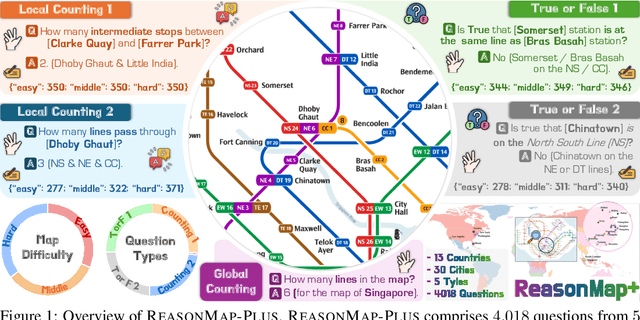
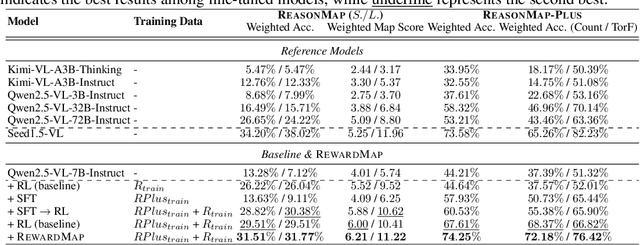
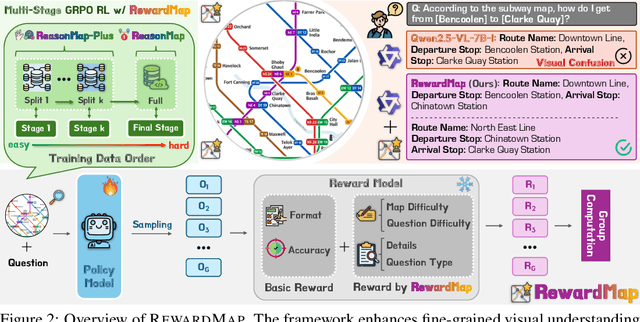

Abstract:Fine-grained visual reasoning remains a core challenge for multimodal large language models (MLLMs). The recently introduced ReasonMap highlights this gap by showing that even advanced MLLMs struggle with spatial reasoning in structured and information-rich settings such as transit maps, a task of clear practical and scientific importance. However, standard reinforcement learning (RL) on such tasks is impeded by sparse rewards and unstable optimization. To address this, we first construct ReasonMap-Plus, an extended dataset that introduces dense reward signals through Visual Question Answering (VQA) tasks, enabling effective cold-start training of fine-grained visual understanding skills. Next, we propose RewardMap, a multi-stage RL framework designed to improve both visual understanding and reasoning capabilities of MLLMs. RewardMap incorporates two key designs. First, we introduce a difficulty-aware reward design that incorporates detail rewards, directly tackling the sparse rewards while providing richer supervision. Second, we propose a multi-stage RL scheme that bootstraps training from simple perception to complex reasoning tasks, offering a more effective cold-start strategy than conventional Supervised Fine-Tuning (SFT). Experiments on ReasonMap and ReasonMap-Plus demonstrate that each component of RewardMap contributes to consistent performance gains, while their combination yields the best results. Moreover, models trained with RewardMap achieve an average improvement of 3.47% across 6 benchmarks spanning spatial reasoning, fine-grained visual reasoning, and general tasks beyond transit maps, underscoring enhanced visual understanding and reasoning capabilities.
Temporal Reasoning with Large Language Models Augmented by Evolving Knowledge Graphs
Sep 18, 2025



Abstract:Large language models (LLMs) excel at many language understanding tasks but struggle to reason over knowledge that evolves. To address this, recent work has explored augmenting LLMs with knowledge graphs (KGs) to provide structured, up-to-date information. However, many existing approaches assume a static snapshot of the KG and overlook the temporal dynamics and factual inconsistencies inherent in real-world data. To address the challenge of reasoning over temporally shifting knowledge, we propose EvoReasoner, a temporal-aware multi-hop reasoning algorithm that performs global-local entity grounding, multi-route decomposition, and temporally grounded scoring. To ensure that the underlying KG remains accurate and up-to-date, we introduce EvoKG, a noise-tolerant KG evolution module that incrementally updates the KG from unstructured documents through confidence-based contradiction resolution and temporal trend tracking. We evaluate our approach on temporal QA benchmarks and a novel end-to-end setting where the KG is dynamically updated from raw documents. Our method outperforms both prompting-based and KG-enhanced baselines, effectively narrowing the gap between small and large LLMs on dynamic question answering. Notably, an 8B-parameter model using our approach matches the performance of a 671B model prompted seven months later. These results highlight the importance of combining temporal reasoning with KG evolution for robust and up-to-date LLM performance. Our code is publicly available at github.com/junhongmit/TREK.
Learning from Diverse Reasoning Paths with Routing and Collaboration
Aug 23, 2025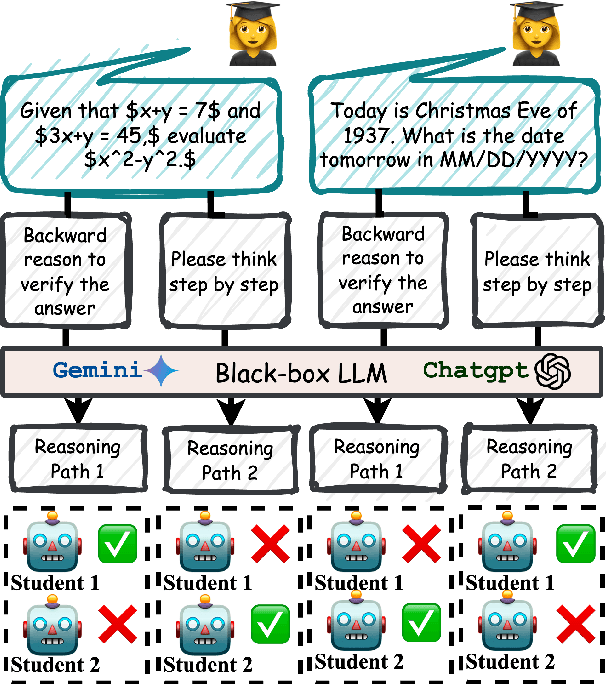
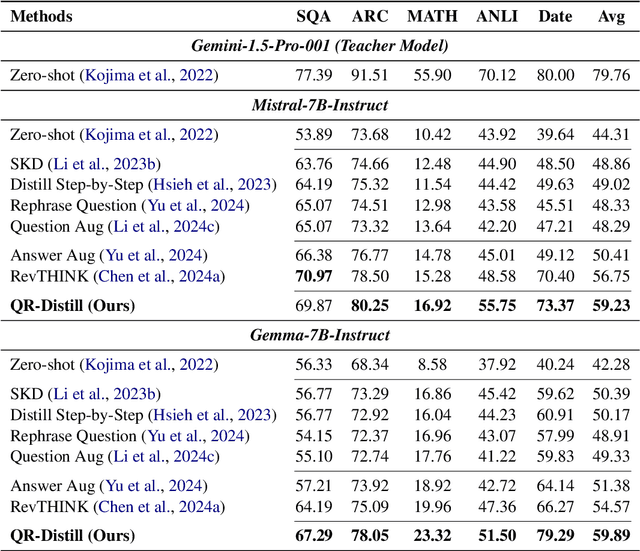
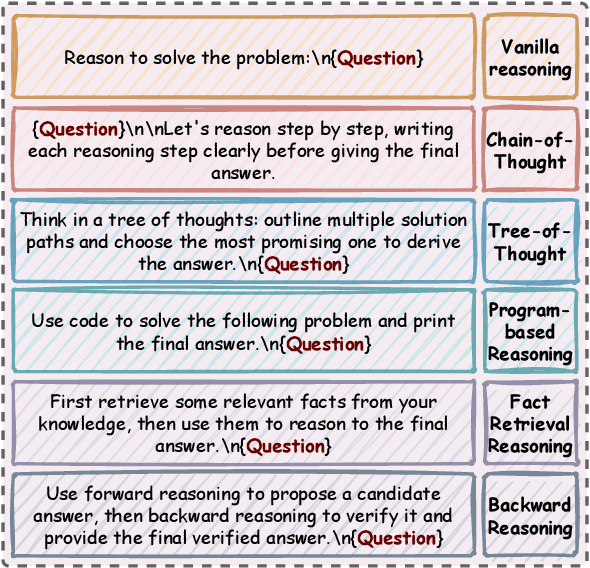
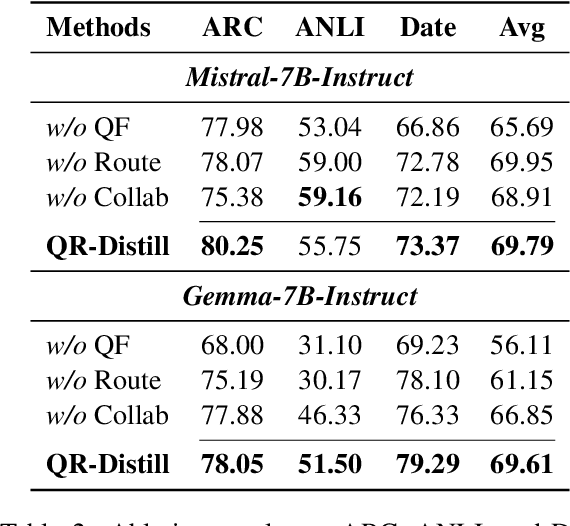
Abstract:Advances in large language models (LLMs) significantly enhance reasoning capabilities but their deployment is restricted in resource-constrained scenarios. Knowledge distillation addresses this by transferring knowledge from powerful teacher models to compact and transparent students. However, effectively capturing the teacher's comprehensive reasoning is challenging due to conventional token-level supervision's limited scope. Using multiple reasoning paths per query alleviates this problem, but treating each path identically is suboptimal as paths vary widely in quality and suitability across tasks and models. We propose Quality-filtered Routing with Cooperative Distillation (QR-Distill), combining path quality filtering, conditional routing, and cooperative peer teaching. First, quality filtering retains only correct reasoning paths scored by an LLM-based evaluation. Second, conditional routing dynamically assigns paths tailored to each student's current learning state. Finally, cooperative peer teaching enables students to mutually distill diverse insights, addressing knowledge gaps and biases toward specific reasoning styles. Experiments demonstrate QR-Distill's superiority over traditional single- and multi-path distillation methods. Ablation studies further highlight the importance of each component including quality filtering, conditional routing, and peer teaching in effective knowledge transfer. Our code is available at https://github.com/LzyFischer/Distill.
A robust and compliant robotic assembly control strategy for batch precision assembly task with uncertain fit types and fit amounts
Aug 17, 2025Abstract:In some high-precision industrial applications, robots are deployed to perform precision assembly tasks on mass batches of manufactured pegs and holes. If the peg and hole are designed with transition fit, machining errors may lead to either a clearance or an interference fit for a specific pair of components, with uncertain fit amounts. This paper focuses on the robotic batch precision assembly task involving components with uncertain fit types and fit amounts, and proposes an efficient methodology to construct the robust and compliant assembly control strategy. Specifically, the batch precision assembly task is decomposed into multiple deterministic subtasks, and a force-vision fusion controller-driven reinforcement learning method and a multi-task reinforcement learning training method (FVFC-MTRL) are proposed to jointly learn multiple compliance control strategies for these subtasks. Subsequently, the multi-teacher policy distillation approach is designed to integrate multiple trained strategies into a unified student network, thereby establishing a robust control strategy. Real-world experiments demonstrate that the proposed method successfully constructs the robust control strategy for high-precision assembly task with different fit types and fit amounts. Moreover, the MTRL framework significantly improves training efficiency, and the final developed control strategy achieves superior force compliance and higher success rate compared with many existing methods.
Complex Logical Instruction Generation
Aug 12, 2025Abstract:Instruction following has catalyzed the recent era of Large Language Models (LLMs) and is the foundational skill underpinning more advanced capabilities such as reasoning and agentic behaviors. As tasks grow more challenging, the logic structures embedded in natural language instructions becomes increasingly intricate. However, how well LLMs perform on such logic-rich instructions remains under-explored. We propose LogicIFGen and LogicIFEval. LogicIFGen is a scalable, automated framework for generating verifiable instructions from code functions, which can naturally express rich logic such as conditionals, nesting, recursion, and function calls. We further curate a collection of complex code functions and use LogicIFGen to construct LogicIFEval, a benchmark comprising 426 verifiable logic-rich instructions. Our experiments demonstrate that current state-of-the-art LLMs still struggle to correctly follow the instructions in LogicIFEval. Most LLMs can only follow fewer than 60% of the instructions, revealing significant deficiencies in the instruction-following ability. Code and Benchmark: https://github.com/mianzhang/LogicIF
A Multi-Stage Large Language Model Framework for Extracting Suicide-Related Social Determinants of Health
Aug 07, 2025Abstract:Background: Understanding social determinants of health (SDoH) factors contributing to suicide incidents is crucial for early intervention and prevention. However, data-driven approaches to this goal face challenges such as long-tailed factor distributions, analyzing pivotal stressors preceding suicide incidents, and limited model explainability. Methods: We present a multi-stage large language model framework to enhance SDoH factor extraction from unstructured text. Our approach was compared to other state-of-the-art language models (i.e., pre-trained BioBERT and GPT-3.5-turbo) and reasoning models (i.e., DeepSeek-R1). We also evaluated how the model's explanations help people annotate SDoH factors more quickly and accurately. The analysis included both automated comparisons and a pilot user study. Results: We show that our proposed framework demonstrated performance boosts in the overarching task of extracting SDoH factors and in the finer-grained tasks of retrieving relevant context. Additionally, we show that fine-tuning a smaller, task-specific model achieves comparable or better performance with reduced inference costs. The multi-stage design not only enhances extraction but also provides intermediate explanations, improving model explainability. Conclusions: Our approach improves both the accuracy and transparency of extracting suicide-related SDoH from unstructured texts. These advancements have the potential to support early identification of individuals at risk and inform more effective prevention strategies.
ChineseEEG-2: An EEG Dataset for Multimodal Semantic Alignment and Neural Decoding during Reading and Listening
Aug 06, 2025Abstract:EEG-based neural decoding requires large-scale benchmark datasets. Paired brain-language data across speaking, listening, and reading modalities are essential for aligning neural activity with the semantic representation of large language models (LLMs). However, such datasets are rare, especially for non-English languages. Here, we present ChineseEEG-2, a high-density EEG dataset designed for benchmarking neural decoding models under real-world language tasks. Building on our previous ChineseEEG dataset, which focused on silent reading, ChineseEEG-2 adds two active modalities: Reading Aloud (RA) and Passive Listening (PL), using the same Chinese corpus. EEG and audio were simultaneously recorded from four participants during ~10.7 hours of reading aloud. These recordings were then played to eight other participants, collecting ~21.6 hours of EEG during listening. This setup enables speech temporal and semantic alignment across the RA and PL modalities. ChineseEEG-2 includes EEG signals, precise audio, aligned semantic embeddings from pre-trained language models, and task labels. Together with ChineseEEG, this dataset supports joint semantic alignment learning across speaking, listening, and reading. It enables benchmarking of neural decoding algorithms and promotes brain-LLM alignment under multimodal language tasks, especially in Chinese. ChineseEEG-2 provides a benchmark dataset for next-generation neural semantic decoding.
 Add to Chrome
Add to Chrome Add to Firefox
Add to Firefox Add to Edge
Add to Edge